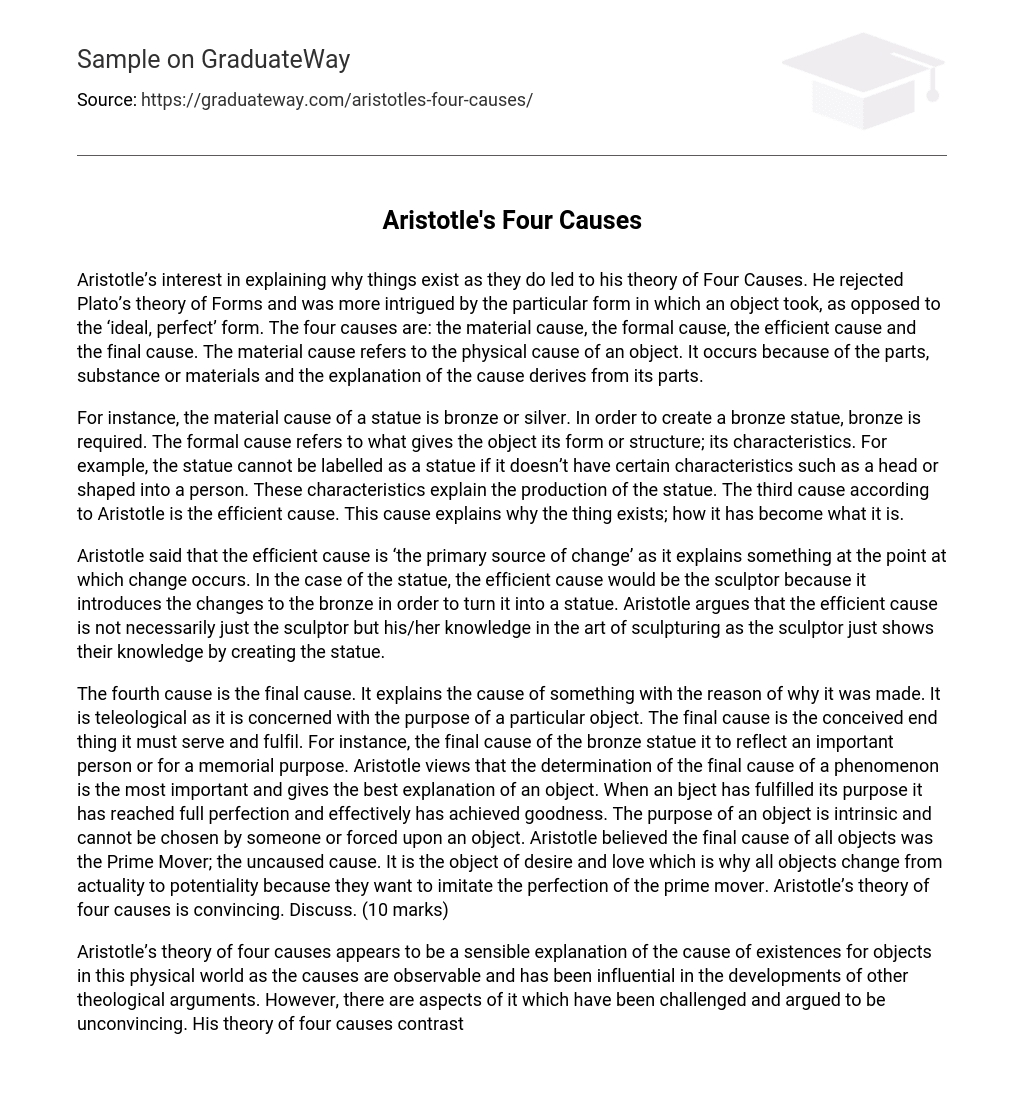Aristotle’s interest in explaining why things exist as they do led to his theory of Four Causes. He rejected Plato’s theory of Forms and was more intrigued by the particular form in which an object took, as opposed to the ‘ideal, perfect’ form. The four causes are: the material cause, the formal cause, the efficient cause and the final cause. The material cause refers to the physical cause of an object. It occurs because of the parts, substance or materials and the explanation of the cause derives from its parts.
For instance, the material cause of a statue is bronze or silver. In order to create a bronze statue, bronze is required. The formal cause refers to what gives the object its form or structure; its characteristics. For example, the statue cannot be labelled as a statue if it doesn’t have certain characteristics such as a head or shaped into a person. These characteristics explain the production of the statue. The third cause according to Aristotle is the efficient cause. This cause explains why the thing exists; how it has become what it is.
Aristotle said that the efficient cause is ‘the primary source of change’ as it explains something at the point at which change occurs. In the case of the statue, the efficient cause would be the sculptor because it introduces the changes to the bronze in order to turn it into a statue. Aristotle argues that the efficient cause is not necessarily just the sculptor but his/her knowledge in the art of sculpturing as the sculptor just shows their knowledge by creating the statue.
The fourth cause is the final cause. It explains the cause of something with the reason of why it was made. It is teleological as it is concerned with the purpose of a particular object. The final cause is the conceived end thing it must serve and fulfil. For instance, the final cause of the bronze statue it to reflect an important person or for a memorial purpose. Aristotle views that the determination of the final cause of a phenomenon is the most important and gives the best explanation of an object. When an bject has fulfilled its purpose it has reached full perfection and effectively has achieved goodness. The purpose of an object is intrinsic and cannot be chosen by someone or forced upon an object. Aristotle believed the final cause of all objects was the Prime Mover; the uncaused cause. It is the object of desire and love which is why all objects change from actuality to potentiality because they want to imitate the perfection of the prime mover. Aristotle’s theory of four causes is convincing. Discuss. (10 marks)
Aristotle’s theory of four causes appears to be a sensible explanation of the cause of existences for objects in this physical world as the causes are observable and has been influential in the developments of other theological arguments. However, there are aspects of it which have been challenged and argued to be unconvincing. His theory of four causes contrasts with Plato’s theory of forms as it isn’t based upon faith and eternal ideas but observation and sensual experience. The Greek empiricist said that the material world is real and that true knowledge is based upon our observation.
His theory is compatible with science as scientific theories are proven through our prior knowledge and observation of the universe. Hence, the theory of four causes is persuasive as it is observable in this physical, materialistic world. The idea of the Prime Mover as the final cause has influenced religious thinking about the reality and nature of God. Thomas Aquinas, a catholic theologian, adopted Aristotle’s concept of the Prime Mover and developed it to create his cosmological argument for the existence of God.
The notion of there being an uncaused cause was appealing to Aquinas which clearly shows the plausibility of Aristotle’s theory of four causes. Aristotle argues that every individual and object has a purpose for its existence, including the universe as a whole. However, it can be argued that not everything requires a purpose for it to exist. Some would argue that the universe’s existence can be entirely random and that there is no evidence of purpose within the universe. Also, there is no evidence of the existence of the eternal and transcendent prime mover.
His theory therefore lacks validity and is unpersuasive. Aristotle’s theory showed that there was more than one explanation for the existence of something. All the causes together contribute to the understanding of the object’s existence. His theory shows that both scientific and religious explanations of the origin of the universe can work together to give us the answer as opposed to being in conflict with each other. The scientific explanation of the Big Bang may refer to the efficient cause whilst at the same time God as the final cause of the universe would correspond to religious beliefs.
His theory is effectively appealing to many people as both science and religion work together to answer a fascinating question of all time. The theory of four causes, somewhat convincingly, explains the existence of objects as it is evident through our sensual experience and has had a significant impact on religious arguments for the existence of God. It has provided more than one explanation for the origins of the universe. However, for some this is not ample enough to convince them of the theory as its lack of evidential backing.





